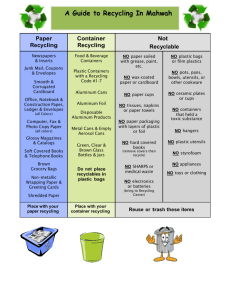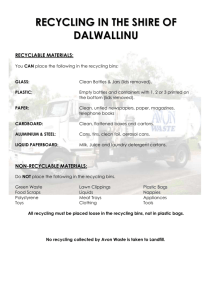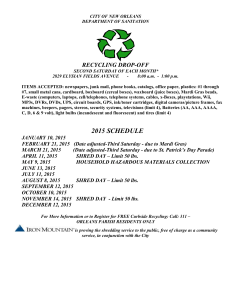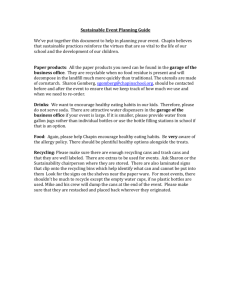Please read this each Thursday in either the morning or the afternoon:
advertisement
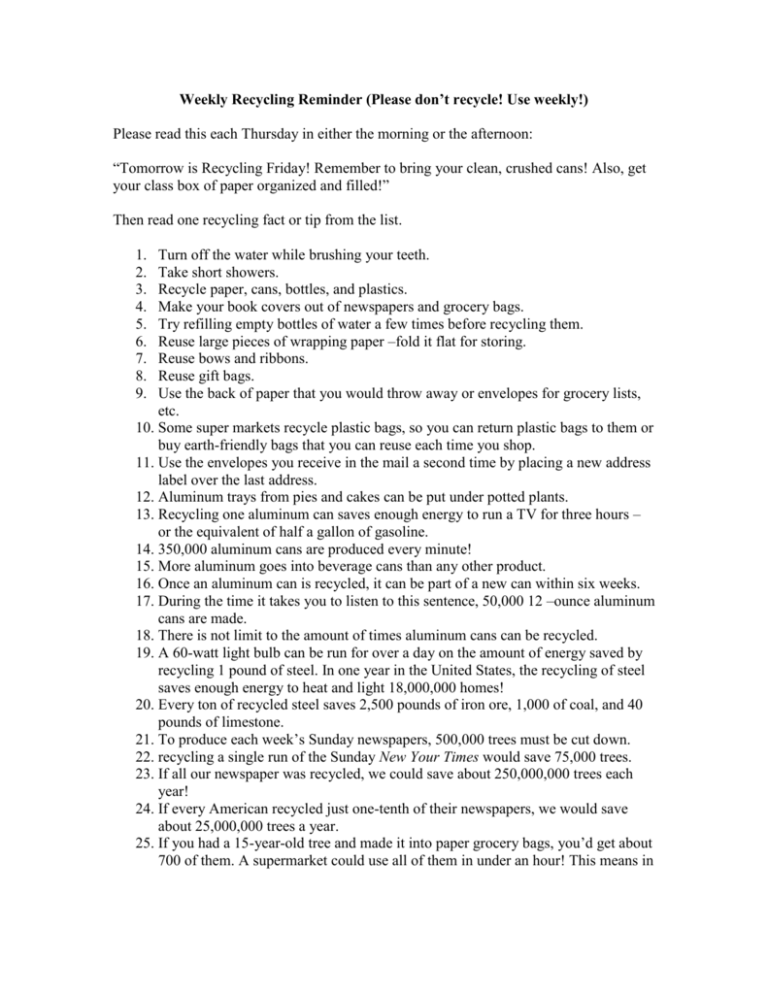
Weekly Recycling Reminder (Please don’t recycle! Use weekly!) Please read this each Thursday in either the morning or the afternoon: “Tomorrow is Recycling Friday! Remember to bring your clean, crushed cans! Also, get your class box of paper organized and filled!” Then read one recycling fact or tip from the list. 1. 2. 3. 4. 5. 6. 7. 8. 9. Turn off the water while brushing your teeth. Take short showers. Recycle paper, cans, bottles, and plastics. Make your book covers out of newspapers and grocery bags. Try refilling empty bottles of water a few times before recycling them. Reuse large pieces of wrapping paper –fold it flat for storing. Reuse bows and ribbons. Reuse gift bags. Use the back of paper that you would throw away or envelopes for grocery lists, etc. 10. Some super markets recycle plastic bags, so you can return plastic bags to them or buy earth-friendly bags that you can reuse each time you shop. 11. Use the envelopes you receive in the mail a second time by placing a new address label over the last address. 12. Aluminum trays from pies and cakes can be put under potted plants. 13. Recycling one aluminum can saves enough energy to run a TV for three hours – or the equivalent of half a gallon of gasoline. 14. 350,000 aluminum cans are produced every minute! 15. More aluminum goes into beverage cans than any other product. 16. Once an aluminum can is recycled, it can be part of a new can within six weeks. 17. During the time it takes you to listen to this sentence, 50,000 12 –ounce aluminum cans are made. 18. There is not limit to the amount of times aluminum cans can be recycled. 19. A 60-watt light bulb can be run for over a day on the amount of energy saved by recycling 1 pound of steel. In one year in the United States, the recycling of steel saves enough energy to heat and light 18,000,000 homes! 20. Every ton of recycled steel saves 2,500 pounds of iron ore, 1,000 of coal, and 40 pounds of limestone. 21. To produce each week’s Sunday newspapers, 500,000 trees must be cut down. 22. recycling a single run of the Sunday New Your Times would save 75,000 trees. 23. If all our newspaper was recycled, we could save about 250,000,000 trees each year! 24. If every American recycled just one-tenth of their newspapers, we would save about 25,000,000 trees a year. 25. If you had a 15-year-old tree and made it into paper grocery bags, you’d get about 700 of them. A supermarket could use all of them in under an hour! This means in one year, one supermarket goes through 60,500,000 paper bags! Imagine how many supermarkets there are in the U.S! 26. The average American uses seven trees a year in paper, wood, and other products made from trees. This amounts to about 2,000,000,000 trees per year! 27. The amount of wood and paper we throw away each year is enough to heat 50,000,000 homes for 20 years! 28. Approximately 1 billion trees worth of paper are thrown away every year in the U. S. 29. Americans use 85,000,000 tons of paper a year; about 680 pounds per person. 30. The average household throws away 13,000 separate pieces of paper each year. Most is packaging and junk mail. 31. Each ton (2,000 pounds) of recycled paper can save 17 trees, 380 gallons of oil, three cubic yards of landfill space, 4,000 kilowatts of energy, and 7,000 gallons of water. This represents a 64% energy savings, a 58% water savings, and 60 pounds less air pollution! 32. The 17 trees saved by recycling 1 ton (2,000 pounds) of paper can absorb a total of 250 pounds of carbon dioxide from the air each year. Burning that same ton of paper would create1,500 pounds of carbon dioxide. 33. Americans use 2,500,000 plastic bottles every hour! Most of them are thrown away! 34. Plastic bags and other plastic garbage thrown into the ocean kill as many as 1,000,000 sea creatures every year! 35. Americans throw away 25,000,000 plastic beverage bottles every hour! 36. Every month, we throw out enough glass bottles and jars to fill up a giant skyscraper. 37. The energy saved from recycling one glass bottle can run a 100-watt light bulb for four hours. It also causes 20% less air pollution and 50 % less water pollution than when a new bottle is made from raw materials.

